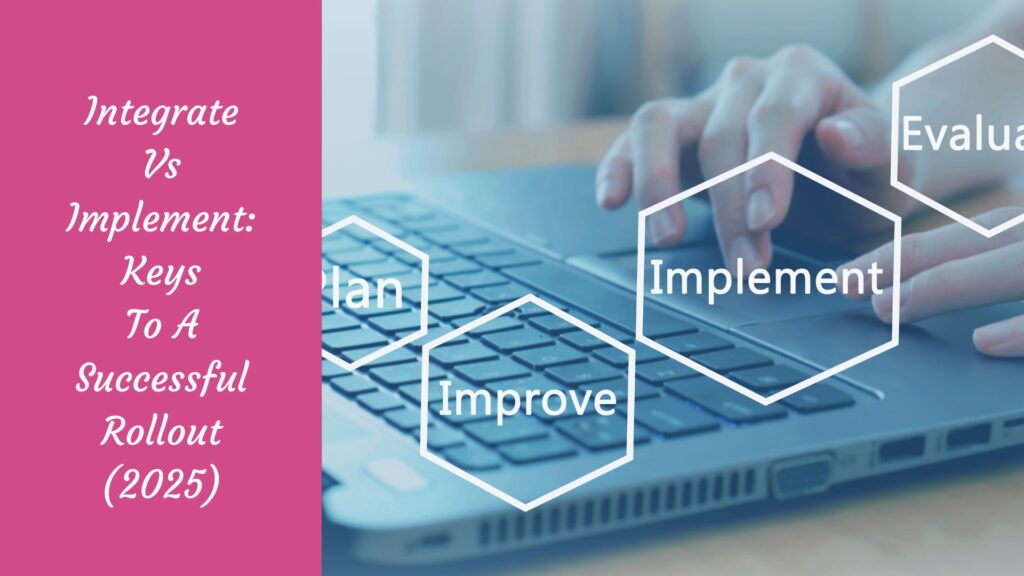In today’s fast-paced world, businesses face the ongoing challenge of not just implementing new technologies but effectively integrating them into their existing systems.
This hurdle can often lead to inefficiency, wasted resources, and missed opportunities—problems you want to avoid. But worry not! Our blog,
Integrate vs Implement: Keys to a Successful Rollout (2025), is your ultimate guide to navigating these waters. We’ll show you the essential strategies to not only introduce new tech smoothly but also ensure its seamless integration for maximum productivity and success.
Read on to transform your rollout approach from a potential headache into a guaranteed triumph.
Laying the Foundation
Integration & Implementation in Action
Bringing Concepts to Life

Real World Examples of Integration
Think about the concept of integration like making a smoothie. You’ve got your fruits (say, apples and bananas), your protein powder, milk, and maybe some honey for sweetness. Individually, they’re all good. But blend them together, and voila, you’ve got something that’s not only cohesive but also enhances each ingredient’s flavor. That’s integration in the business world. Here are a couple of examples:
- Software Integration: Imagine a company, Widgets Inc., uses one software for orders, another for accounting, and a third for customer management. By integrating these systems (ERP software, for instance), they create a single, harmonious system. This integration enables data to flow freely between departments, making operations more efficient and reducing the risk of errors.
- System Integration: This is like adding an Amazon Alexa to your home setup. Alone, it’s cool; it can play music or tell you the weather. But integrate it with your lights, your thermostat, and your security system, and suddenly you’ve got a smart home. Businesses do the same thing but on a larger scale. For example, a retailer could integrate their online shopping platform with their in-store inventory system, enabling real-time stock updates and smoother customer experiences.
A Closer Look at Implementation
Now, if integration is making the perfect smoothie, then implementation is like picking out the right blender. You could have all the best ingredients (software and systems), but without the right tool to mix them (implementation strategy), you won’t get the smoothie (or business efficiency) you’re looking for. Implementation involves:
- Choosing the right technology to meet your company’s needs.
- Configuring the system to fit within your existing operations.
- Training your team to use the new system effectively.
- Launching the system, closely followed by monitoring and adjustments as needed.
For example, consider a sales team implementing a CRM system for the first time. The process includes software selection, adjusting the features to match the sales process, training the team on the software, and finally, going live. Post-implementation, the team would gather feedback for any adjustments to improve functionality and user experience.
The Digital Era Difference

How Integration and Implementation Fuel Efficiency
Business efficiency isn’t just a buzzword; it’s a must-have in today’s competitive landscape. Good integration and implementation are like secret ingredients.
Take the case of Zappos, an online shoe and clothing retailer. By integrating their customer service software with their order management system, they’ve streamlined operations enabling them to handle queries more quickly and accurately, significantly boosting efficiency.
Integration as a Customer Service Game Changer
In the age of instant gratification, customer service can make or break a business. Integration plays a massive role in improving this. Look at Uber; by integrating a variety of systems (GPS, payment processing, user feedback), they’ve created a seamless experience for users, making it incredibly easy to book, pay for, and rate trips, setting a high bar for customer service.
Both integration and implementation are key to a successful digital transformation. By understanding and applying these concepts, companies can not only improve their operational efficiency but also enhance the overall customer experience, keeping them competitive in the rapidly evolving digital landscape.
Integration in Focus

Strategies for Successful Integration
Identifying Integration Needs
The first step to a bang-up integration strategy is to play detective with your current tech stack. Think of it as doing a thorough home inspection before deciding to remodel. You’re looking for:
- The places where data or processes get jammed up because systems can’t talk to each other.
- Opportunities where sharing information between applications could turn a two-step process into a one-stepper.
A hot tip? Look for frequent manual data entries or places where employees switch between apps to complete tasks. These are dead giveaways that your systems might benefit from a good old powwow.
Choosing the Right Integration Tools
Choosing the right tools for integration isn’t about picking the shiniest in the toolbox; it’s about finding the right fit for your team’s needs. Here in 2025, we’re spoiled for choice with platforms that are smarter and more intuitive than ever. The trend is leaning heavily on AI-driven integration platforms like Zapier, which automates tasks between web apps, or MuleSoft, a beast at connecting enterprise applications on-premises and in the cloud. Key pointers include:
- Search for tools that best align with your business needs. If you’re in e-commerce, Shopify’s API might be your new best friend.
- Don’t ignore the new kids on the block. AI-driven tools have made significant strides, offering predictive insights and automation capabilities that were the stuff of sci-fi a decade ago.
Overcoming Common Integration Challenges

H3: Data Silos and Incompatibility
One of the stickiest wickets in integration is dealing with data silos and incompatible systems. Imagine trying to make a group of cats walk in a parade; it’s not pretty. The key to overcoming this is:
- Employing middleware solutions or using APIs that act as translators, allowing previously incompatible systems to communicate freely.
- Conducting data mapping exercises to identify how data from different sources will merge and interact.
Experts often recommend platforms like Talend for their robust data integration and transformation capabilities, especially in tackling the Herculean task of merging disparate data sources.
Security Concerns
Last but never least, is securing the fort while all these new connections are being made. It’s like inviting guests over but forgetting to lock the back door. Here are some best practices that still hold up in 2025:
- Implementing robust access controls and encryption methods to ensure that only authorized eyes peek at your data.
- Regularly reviewing integration points for potential vulnerabilities, because, as we all know, the baddies never sleep.
Organizations are turning to solutions like Okta for their sterling reputation in managing identities and access controls across cloud and on-premise applications.
Through smart strategies and leveraging cutting-edge tools, businesses can tackle integration challenges head-on, paving the way for smoother operations and bolstering security for a tech-savvy future that’s already here.
Implementation Unveiled
Effective Implementation Planning

Setting Clear Objectives
In the world of tech implementation, knowing what you want is half the battle. Think about it like planning a road trip. You don’t just decide to go “somewhere” — you pick a destination, right? It’s the same deal here. Setting clear, measurable goals gives everyone a roadmap to success. For instance, if you’re rolling out new project management software, a solid objective could be, “Reduce project turnaround time by 20% within six months.” This isn’t just a shot in the dark; it’s a target everyone can aim for. Websites like Smartsheet often highlight the importance of measurable goals in project management success stories, showing just how critical this step is.
Stakeholder Engagement
Now, imagine trying to plan that road trip without talking to your travel buddies. Chaos, right? That’s why involving stakeholders early and often in the implementation process is critical. Whether it’s the IT team who’ll manage the tech or the sales crew who’ll use it daily, getting their buy-in and feedback can make or break your project. To ensure everyone’s on board, try strategies like:
- Hosting kickoff meetings to share the vision and benefits of the new tech.
- Running regular check-ins to address concerns and gather input.
- Sharing success stories from similar organizations to build confidence.
Sites like Forbes are loaded with articles on the importance of stakeholder engagement in successful project implementation, offering real-world examples of both triumphs and cautionary tales.
Navigating Implementation Hurdles
Managing Change Resistance
Resistance to change is as American as apple pie. It’s only natural for folks to stick to their guns, especially with new tech on the horizon. The trick is to manage this resistance with a mix of empathy and strategy. For instance, showing how the new system makes life easier can turn skeptics into advocates. Also, appointing a change champion within each team can help spread positive vibes about the new tech. Articles on popular sites like Harvard Business Review spill the beans on effective change management techniques, offering advice right from the trenches.
Ensuring Technical Readiness
Lastly, before you hit the “go” button, you’ve gotta make sure your IT infrastructure is up to snuff. It’s like checking your car’s oil before a big trip. This could mean upgrading your servers, ensuring robust internet connectivity, or training your IT staff on the new systems. To avoid hiccups, consider:
- Conducting a tech audit to identify gaps in your current setup.
- Planning phased rollouts to test systems under real conditions.
- Setting up a support hotline for immediate troubleshooting.
Tech websites like TechCrunch often spotlight how companies overcome technical hurdles in their tech implementation stories, providing a treasure trove of dos and don’ts.
By addressing these key areas with thoughtfulness and precision, organizations can pave the way for a smooth tech implementation process, ensuring their teams are ready to hit the ground running with new tools at their disposal.
Synergizing integrate vs implement
Creating a Holistic Approach for Tech Rollouts

Integration and implementation in the tech world might sound like IT jargon, but think of them as bringing a new guest to a party (integration) and making sure they get along with everyone (implementation). To ensure these two go hand in hand without stepping on each other’s toes, consider the following strategies:
Aligning integrate vs implement Strategies
- Clarity in Communication: Just like in any top communication skills guide, clear objectives and frequent updates ensure that everyone understands how the integration will happen and how the new system will be used.
- Unified Team Objectives: Whether it’s through a collaborative project management tool or regular cross-departmental meetings, ensuring every team member is on the same page is crucial.
- Flexible Frameworks: Use models that are adaptable, like Agile or Scrum, so that your implementation can adjust as the integration evolves.
Continuous Evaluation and Adaptation
- Feedback Loops: Regularly collect feedback from users via surveys or feedback tools to understand where tweaks are needed.
- Performance Metrics: Keep an eye on KPIs to measure the success of both integration and implementation efforts, making changes as necessary.
Real-world Examples of Successful Rollouts

The proof is always in the pudding, and these examples from both SMEs and large corporations show how it’s done:
Small and Medium Enterprises (SMEs)
- A Local Retail Chain: They boosted sales by 30% by integrating an eCommerce platform (Shopify) with their existing POS system, then implementing mobile checkout capabilities across stores for a seamless customer experience.
- Tech Startup: A tech startup managed to streamline its project delivery by integrating project management software (Jira) with their existing CRM system, then effectively implementing Agile methodologies across teams.
Large Corporations
- Global Telecommunications Company: They successfully integrated their customer service software with AI-driven chatbots, then implemented a comprehensive training program for their support team, significantly reducing response times.
- Multinational Bank: This corporation merged its legacy systems with a cloud-based infrastructure (AWS) and then systematically implemented new security protocols, greatly enhancing data protection and operational efficiency.
By taking cues from these examples and focusing on synergizing integration with implementation, companies can not only adapt to new technologies but thrive with them.
- Ongoing Training: Continuous learning opportunities ensure that employees keep up with the new system, as recommended by LinkedIn Learning.
Looking Ahead
In the fast-paced world of tech, keeping an eye on the horizon isn’t just smart; it’s essential. Here’s the down-low on what’s coming our way and how you can prep your business for the future.
Emerging Trends in Integration and Implementation
The Role of AI and Machine Learning

- Smarter Automation: Imagine AI like a super-efficient intern that never sleeps. Companies like Google are pumping out AI capabilities that can automate complex data analyses without batting an electronic eye, saving tons of time.
- Optimized Processes: Tools powered by Machine Learning, such as IBM Watson, are getting real good at predicting issues before they even pop up. This means businesses can stay two steps ahead, refining their tech implementation to be smoother and more effective.
The Future of Remote Work Technologies
- All About Flexibility: With giants like Zoom and Slack becoming household names, the remote work tech scene is booming. The future? Tools that not only make collaboration easier but also seamlesser (if that’s a word), bridging physical gaps like never before.
Preparing Your Organization for Future Rollouts
Building a Flexible IT Infrastructure
- Cloud-Based Everything: Hitching your wagon to cloud services like Amazon Web Services (AWS) isn’t just trendy – it’s pivotal. It’s about creating a setup where you can plug in new tech as easily as snapping LEGO bricks together.
- Adapt or Bust: Keep an eye on modular infrastructure systems that allow you to adapt without overhauling your entire tech setup every couple of years.
Fostering a Culture of Innovation
- Encourage Curiosity: Companies like Google and 3M have long embraced policies that allow employees to spend time on personal projects. Why? Because innovation comes from curiosity.
- Lifelong Learning: Offering access to continued learning opportunities, think Coursera or Udemy, helps keep your team’s skills sharp and your business ahead of the curve.
In wrapping up, the future of tech in business is all about staying adaptable, leveraging AI for smarter processes, and ensuring your team is primed for change. Sprinkle in a culture that champions innovation, and you’re not just ready for the future; you’re set to define it.
FAQs
1. What’s the difference between ‘integration’ and ‘implementation’ in the context of tech rollouts?
Integration refers to the process of bringing together various subsystems or components into one cohesive system that works seamlessly. It’s about ensuring different technologies, software, or systems can communicate and operate together effectively. In contrast, implementation is the act of installing, setting up, and adopting a new system or technology within an organization. It focuses on the practical aspects of making a new technology operational and useful for its intended purposes.
2. Why is understanding the difference between integration and implementation crucial for businesses in 2025?
As technologies evolve at an unprecedented pace, businesses in 2025 face the challenge of not just adopting new technologies but ensuring they work harmoniously with existing systems. Understanding the distinct roles of integration and implementation empowers businesses to plan more effective tech rollouts, avoid common pitfalls, and maximize both efficiency and ROI. This distinction is especially critical as businesses leverage complex technologies like AI, IoT, and blockchain, where seamless interaction and flawless functionality are key to unlocking their full potential.
3. How can businesses overcome common challenges in integration and implementation processes?
To overcome common challenges in integration, businesses can focus on choosing the right tools and platforms that offer flexibility, scalability, and compatibility with existing systems. Additionally, addressing data silos and ensuring robust cybersecurity measures are fundamental steps. For implementation, key strategies include thorough planning, engaging stakeholders early and often, managing change resistance through effective communication and training, and ensuring technical readiness of the IT infrastructure. Employing iterative testing and feedback loops can also help in smoothing out any issues during the implementation phase.
4. What role do emerging technologies play in the integration and implementation of new systems in 2025?
Emerging technologies such as artificial intelligence (AI), machine learning (ML), and the Internet of Things (IoT) are playing pivotal roles by automating and optimizing the integration and implementation processes. AI and ML, for instance, can predict integration challenges, automate data mapping, and facilitate smoother data integration. These technologies also enable more personalized user experiences during implementation, making the adoption of new systems more intuitive and less disruptive.
5. How can businesses future-proof their integration and implementation strategies as they prepare for 2025 and beyond?
Future-proofing integration and implementation strategies involves building a flexible and adaptable IT infrastructure that can easily accommodate new technologies as they emerge. Businesses should foster a culture of continuous learning and innovation, ensuring teams are prepared to leverage new tools and methodologies. Staying informed about evolving technologies and industry trends is also crucial. Additionally, prioritizing cybersecurity and developing robust data management practices will ensure that businesses remain resilient in the face of changing technological landscapes.
Conclusion
In conclusion, integrating cutting-edge technology with strategic implementation plays a crucial role in driving business success. By learning from real-world examples and preparing for future trends, organizations can achieve efficiency, foster innovation, and maintain a competitive edge. Encouraging a culture of continuous learning and adaptation to new technologies is key to staying ahead. For those eager to further explore how technology can transform your business, LEARN MORE about harnessing the power of integration and implementation.

10+ years experience in Marketing and Operations
